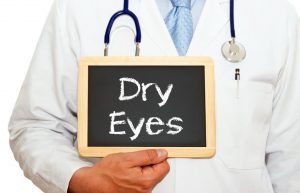Posted by: Metrolina Eye Associates in Dry Eyes

 Dry eye syndrome is a very common eye condition seen in eye doctors offices every day. This condition can range from being mild with barely any symptoms, to severe and affecting someone’s daily life and functioning.
Dry eye syndrome is a very common eye condition seen in eye doctors offices every day. This condition can range from being mild with barely any symptoms, to severe and affecting someone’s daily life and functioning.
Common symptoms include burning, itching, tearing, redness and blurry vision and can be seen at any age, although older patients and post menopausal women tend to have worse cases of this condition. There are also 3 components to a normal tear film. These include: an oily lipid component, a water liquid component, and a mucous like component. There are different types of dry eye and each type can be treated differently.
The first type is known as evaporative. This is caused by an outer lipid layer tear deficiency and the patient will commonly have blepharitis or meibomian gland dysfunction associated. The second type of hyposecretory where the deficiency is the middle aqueous tear layer. Some patients present with a combination of the two of these.
Symptoms of blepharitis are very similar to dry eye and include itching, burning, foreign body sensation, but also may have crusting around the eyes upon awakening. Dry eye symptoms are usually worse later in the day.
Watery eyes can also be a symptom of dryness, which confuses many patients. Because dryness on the eyes surface sometimes will over stimulate production of the watery component of years as a protective mechanism. But the reflex tearing doesn’t stay on the eye long enough to correct the condition.
There are many different things that can cause dry eye. One cause is medications with the most common being antihistamines, anti depressants and blood pressure medications. Other causative factors include heat, air conditioning, ceiling fans, smoke and computer use. Certain diseases also present commonly with dry eye including Sjogrens syndrome, rheumatoid arthritis and lupus. Some procedures including cataract surgery and lasik can provoke dry eyes in some patients.
Treatment for dry eye all depends on the severity. Many doctors start with artificial tears as treatment such as Refresh Preservative free tears in the vial form. There are several prescription dry eye drops such as restasis and xiiadra which are both used twice a day. Steriod drops can also be used to help if the dry eye is inflammatory. Metrolina Eye Associates has state of the art dry eye technology to assist in diagnosing and treating dry eye such as ILUX, IPL, tear lab, inflammadry, and punctal plugs.
Metrolina Eye Associates has successfully treated many patients with severe dry eye. Call our office to make an appointment today.